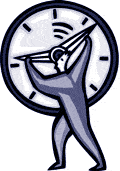|
|
|
Summer
2002 Vol. 46, Number 2
|
|
Grab Bag
|
 Download the PDF
(66K)
Download the PDF
(66K)
Grab Bag from past issues
|
Nursing scholarships and information
More than 1 million new registered nurses will be needed between 2000 and 2010, according to the Bureau of Labor Statistics (BLS). Nurses should be able to find plenty of opportunities: a study by the American Hospital Association and other organizations found a 13-percent average vacancy rate for registered nursing jobs in 2001. Along with good job prospects, nurses enjoy high pay, with BLS data showing their median earnings in the top quartile for all workers.
If statistics like these tempt you to
consider a nursing career, two associations can help you get
started. The Johnson and Johnson Foundation for Nursing’s
Future offers free information about nursing careers. Call
tollfree, 1 (888) 981–9111 for brochures, posters, and
videos that briefly describe nursing specialties, the types
of training available, and nurses’ earnings, benefits, and
employment prospects. An online version of these and more
in-depth recruiting materials, together with a database of
scholarships and schools, is available at www.discovernursing.com. Johnson and Johnson Foundation for Nursing’s
Future offers free information about nursing careers. Call
tollfree, 1 (888) 981–9111 for brochures, posters, and
videos that briefly describe nursing specialties, the types
of training available, and nurses’ earnings, benefits, and
employment prospects. An online version of these and more
in-depth recruiting materials, together with a database of
scholarships and schools, is available at www.discovernursing.com.
The National Student Nurses Association
offers more than $100,000 in scholarships to nursing
students every year. For more information, call (718) 210–0705
or visit www.nsna.org/career/index.html before the
February 1 application deadline. Also available on the
Association’s Web site is career information, including
booklets and articles describing nursing school and life on
the job.
 Top
Top
|
Employers’ participation in school-to-work
Programs that expose students to the workplace all share one essential ingredient: employer participation. A survey by the Society for Human Resources Management offers some insight into why employers choose or decline participation in job shadowing, internships, and mentoring.
The major barriers to involvement, according to
the study, are lack of entry-level positions (cited by 52
percent of nonparticipants), insufficient knowledge of programs
(cited by 25 percent), and lack of time (18 percent) and
expertise (7 percent). Liability and cost were stumbling blocks
for 5 and 3 percent of nonparticipants, respectively.
For additional survey results, including
employers’ views on the effectiveness of various
school-to-work programs, call (703) 548–3440 to order the
report. You may also read the report online at www.shrm.org/surveys/results.
 Top
Top
|
No more 9 to 5? Flexible hours for many
Flexible work schedules are becoming common, especially for workers in some occupations.
In May 2001, about 29 percent of all
full-time, wage-and-salary workers set their own starting
and stopping times, according to BLS. That’s more than
double the number who reported having flexible hours 10
years ago. Most flexible scheduling arrangements were
informal, but 11 percent of workers had formal flextime
agreements with their employers.
percent of workers had formal flextime
agreements with their employers.
Freedom from the time clock varied by
occupation. More than half of full-time college teachers,
mathematical and computer scientists, and natural scientists
could set their own schedules. And about 46 percent of
executives, administrators, and managers and 41 percent of
salesworkers could. In contrast, only about 18 percent of
precision production, craft, and repair workers varied their
work times at will.
Even with these high rates of flexibility,
however, working from 8:30 a.m. to 5 p.m. remains the most
popular schedule. About 24 percent of workers start between
8 and 8:30 a.m., and about 30 percent end between 5 and 5:30
p.m.
For more information on this survey, see the
news release online at www.bls.gov/news.release/flex.toc.htm.
You may also call BLS’s Current Population Survey office
at (202) 691–6378 or through the tollfree U.S. Department
of Labor number, 1 (866) 487–2365.
|
|

Free career guidance from the military
Regardless of whether you’re interested in joining the military, the U.S. Department of Defense can help you make career decisions.
One resource the Department offers is a free
career aptitude test, the Armed Services Vocational Aptitude
Battery (ASVAB). The test measures ability in basic
subjects, such as language, mathematics, and mechanics. All
those enlisting in the military take this test to determine
which occupations they are qualified for, but anyone who is
at least a high school sophomore can take the test. And test
takers have no obligation to join the military.
A free career exploration workbook, also
offered by the Department of Defense, includes a career
interest test and matches the scores on the interest and
aptitude tests with civilian and military occupations.
Another section of the workbook describes career exploration
techniques.
To take the ASVAB and receive the career
exploration workbook, register with your high school
guidance counselor. To learn more about the ASVAB and about
military careers and training, visit www.todaysmilitary.com
or www.militarycareers.com. Or, call tollfree, 1
(888) 855–HERO (4376).
 Top
Top
|

|
|
 |

|
Eighth graders, 12 years later
How was the eighth-grade class of 1988
faring a dozen years later? A survey by the U.S. Department
of Education set out to answer that question.
As part of an ongoing longitudinal study, a new report
describes the labor market and educational experiences,
marriage and family creation, and civic activity of people
who were in the eighth grade in 1988. According to the
study:
-
Most of the group liked their jobs, with
86 percent of the employed satisfied overall, 79 percent
satisfied with job security, and 71 percent satisfied
with their promotion opportunities. Satisfaction was
even higher for those with college degrees, reaching an
overall rate of 94 percent for those with master’s
degrees.
-
Forty-seven percent of the group had
earned some college credits, but not a degree, after
high school; 29 percent had earned a bachelor’s
degree. Those who, as eighth graders, had taken algebra,
participated in extracurricular activities, or attended
private school were more likely to earn college
credits.
-
Sixty-one percent of the group had
received job training during the year before the survey.
Those who had high school diplomas or college degrees or
who had scored higher on eighth grade mathematics tests
were most likely to have had training.
For more study results, order a copy of
“Coming of Age in the 1990’s: The Eighth Grade Class
of 1988 12 Years Later” by calling tollfree, 1 (877)
4-ED-PUBS (433–7827). You also may view the report
online at nces.ed.gov/pubs2002/2002321.pdf. |
|
|
|
|
|



